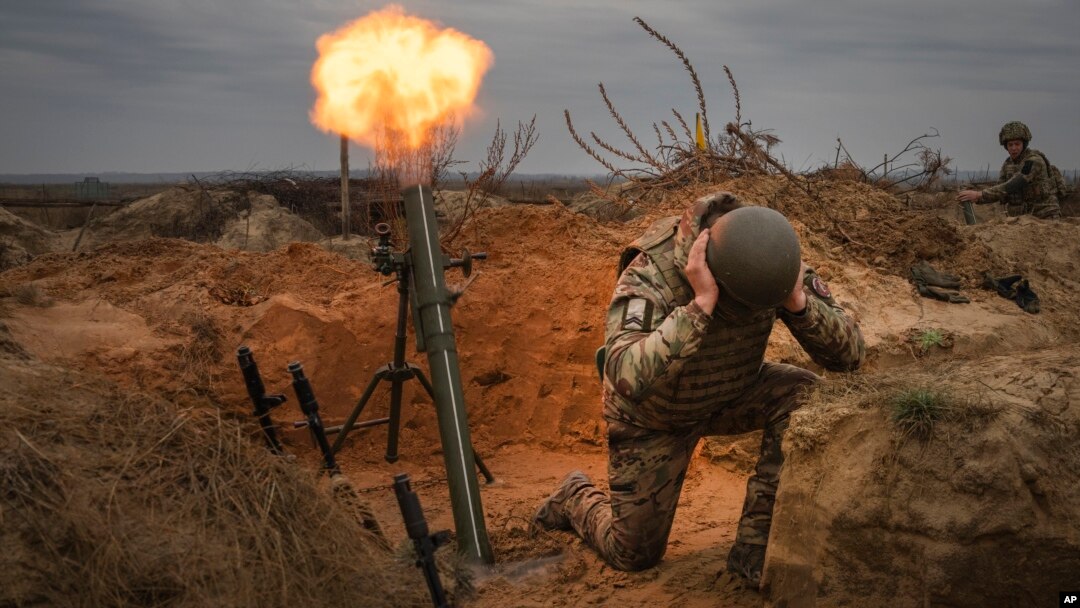NATO Secretary-General Jens Stoltenberg has called on Ukraine's allies to continue giving Kyiv all the necessary military support it needs in its war against Russia's aggression and warned that they have to be prepared for a protracted battle, even as air-raid sirens blared over the Kyiv region late on November 10 and authorities urged residents to take cover.
"We have to keep giving the Ukrainians the weapons they need to stay strong on the battlefield today, so they can be strong at the negotiating table tomorrow," Stoltenberg said after talks with German Chancellor Olaf Scholz in Berlin.
"These contributions help Ukraine defend its freedom and they help keep Europe safe," he said.
But Stoltenberg cautioned in an interview with the German news agency dpa that it could take a long time for Ukraine and its allies to achieve their goals.
"We have to be ready for the long term. Wars are by their very nature unpredictable. What we know for sure is that what happens at the negotiating table is inextricably linked to the situation on the battlefield," Stoltenberg said.
Aided by military supplies from its allies, Ukraine launched a counteroffensive in the spring to regain territory lost since the start of Russia's unprovoked invasion in February last year.
But the counteroffensive has advanced more slowly than expected, sparking concerns of "war fatigue" among Kyiv's Western allies, especially in the United States -- Ukraine's main provider of military and financial aid.
The NATO chief told dpa that it had been obvious from the outset that the fight would be very difficult given Russia's time to prepare.
"We knew that Russia has prepared defensive lines for months -- with mines, with tank trenches, with a lot of defensive positions."
But Ukrainian troops "have been able to make gains and to liberate more territory" despite the difficulties it faced on the battlefield, he said.
Meanwhile, authorities in and around the capital urged people to seek safety in basements and other secure areas as air-raid sirens blared just before midnight.
There was no immediate word of damage or injuries.
Elsewhere, the British government on November 10 announced that 30,000 Ukrainian troops have completed training in Britain seven weeks ahead of schedule, what it said was "the largest U.K. military training effort since World War II."
In Kyiv, Ukrainian Air Force spokesman Yuriy Ihnat said on November 10 that training for Ukrainian pilots on the F-16 fighter jet is going according to plan, adding that some pilots are already undergoing "training in the sky." He did not give further details.
The U.S. Air Force announced late last month that a number of Ukrainian pilots had begun training to fly advanced F-16 fighter jets in the U.S. state of Arizona. They are expected to begin flying F-16s in combat sometime next year. Several European countries are also training Ukrainian pilots to fly them.
Earlier on November 10, the Main Intelligence Directorate of Ukraine's Defense Ministry confirmed that its forces had damaged two Russian landing boats in occupied Crimea in a strike early on November 10.
"Yes, this information is true," intelligence official Andriy Yusov told RFE/RL following reports by two Ukrainian publications -- Suspilne and Hromadske. "Two landing craft were damaged," Yusov said.
WATCH: The European Commission has recommended opening EU accession negotiations with Ukraine, while it also recommended opening talks with Moldova once it meets final conditions. RFE/RL Europe editor Rikard Jozwiak explains what the commission's recommendations mean.
Your browser doesn’t support HTML5
Explainer: What Is The European Commission's Annual Enlargement Package About?
The media reports said the strike occurred in Chornomorske, in the westernmost part of Crimea, and that it targeted two Russian high-speed landing boats.
The Russian Defense Ministry earlier said its air defenses had “intercepted” and “destroyed” three Ukrainian drones over the territory of occupied Crimea and the Tula region, south of Moscow.
Vyacheslav Gladkov, the governor of Russia's Belgorod region, said that three districts were shelled from across the Ukrainian border. Gladkov said no injuries or damage was reported.
Separately, the Russian Defense Ministry said late on November 10 that air-defense forces had intercepted two Ukrainian drones over the territories of the Moscow and Smolensk regions just before midnight.
Details remained scarce and it was not possible to immediately confirm the report. Ukraine generally does not comment on reported attacks inside of Russia.
Ukraine's air defenses reported in turn that Russian drone attacked the regions of Dnipropetrovsk, Kharkiv, Mykolayiv, Poltava, and Kyiv early on November 10. It said that five Iranian-made drones and one cruise missile were shot down.
Serhiy Lysak, governor of Ukraine’s Dnipropetrovsk region, said a 67-year-old woman was killed and a 68-year-old man was injured in the Russian drone attack in Nikopol.
Lysak said at least 11 homes, a gas pipeline, and power lines were damaged in the attack on the city of some 105,000 people on the Dnieper River.
In the southern region of Kherson, two people were killed and five were wounded by Russian shelling over the past 24 hours, regional Governor Oleksandr Prokudin said on November 10.
On the battlefield, Ukrainian forces fought 69 close-quarter battles along the entire front line, the General Staff of Ukraine's military said early on November 10. It said Ukrainian forces repulsed dozens of "unsuccessful attacks" in areas of southeastern and southern Ukraine that have seen heavy fighting for weeks.


